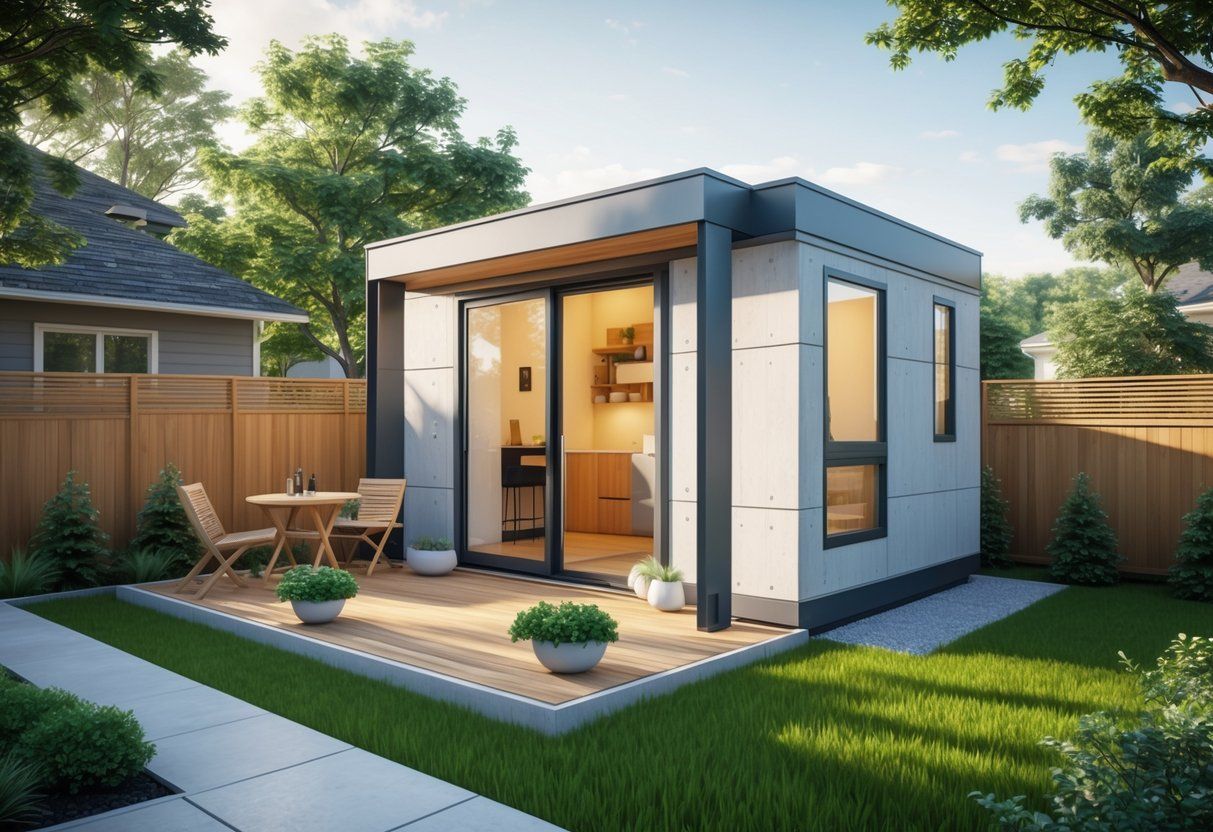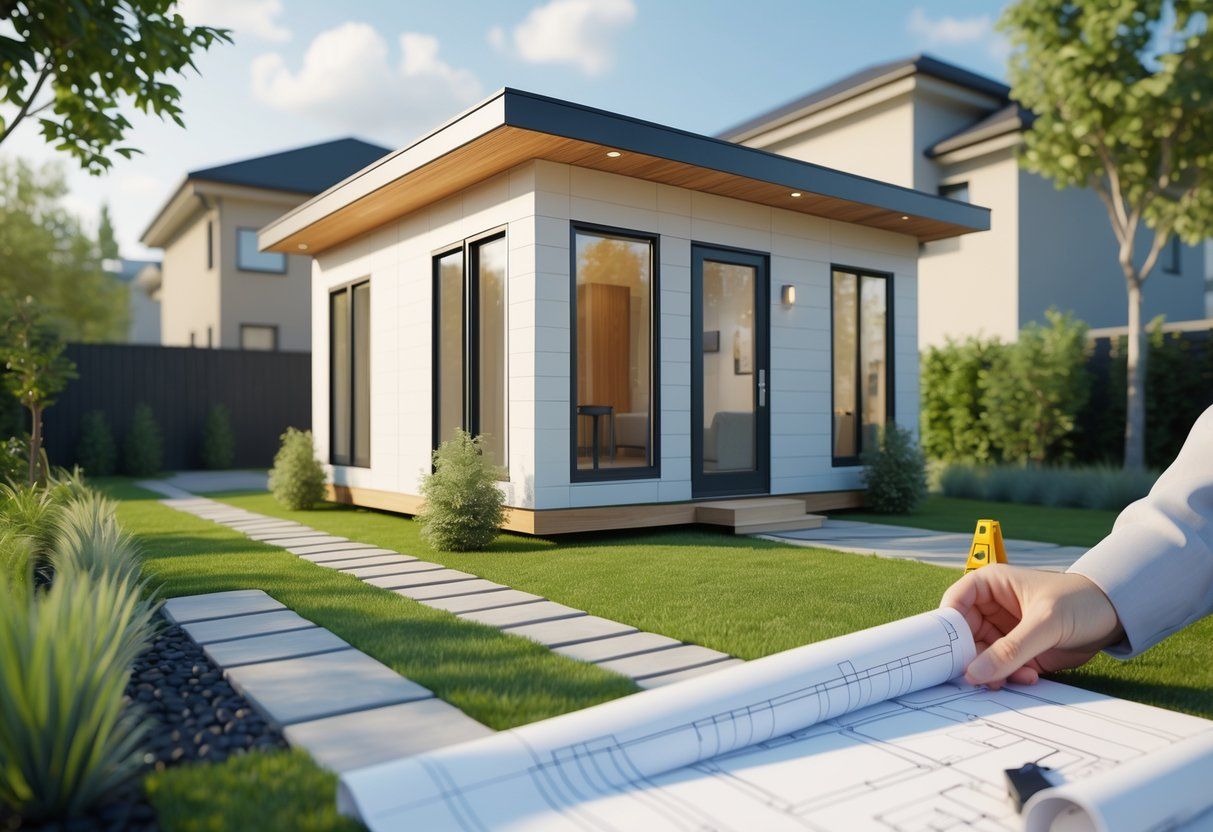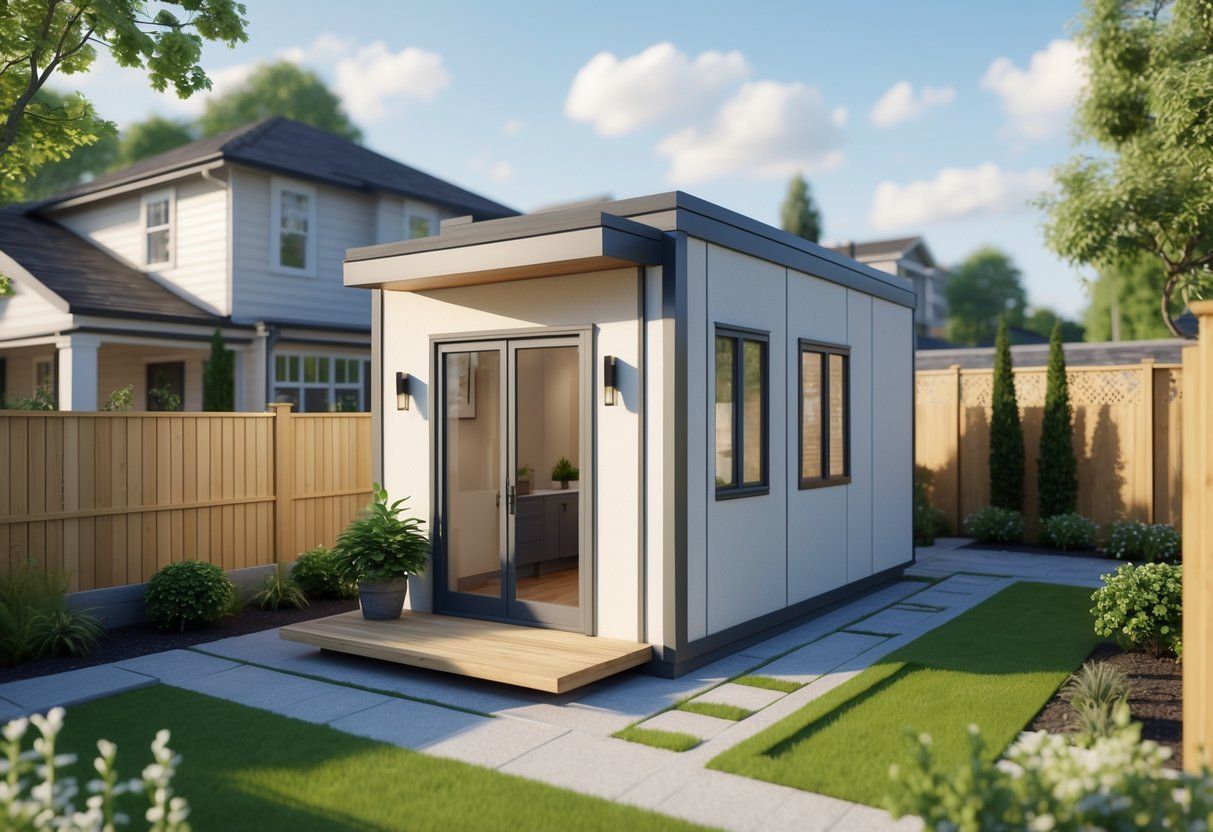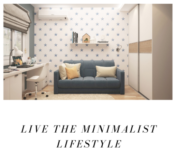Table of Contents
Easy ADU: The Simplest Solutions for Affordable Accessory Dwelling Units
Building an ADU doesn’t have to be overwhelming or expensive. Many homeowners avoid adding accessory dwelling units because they think the process is too complex or costly. The easiest ADU options include prefab kits, garage conversions, and streamlined design-build services that can cost as little as $18,000 and be completed in just a few months.

You have several straightforward paths to create additional living space on your property. Prefab ADU kits offer the most affordable option, especially if you’re comfortable with DIY construction. These kits come with plans, materials, and step-by-step instructions that make the building process much simpler than traditional construction.
The key to an easy ADU project is choosing the right approach for your budget, timeline, and skill level. Whether you want a simple backyard office, a rental unit for extra income, or housing for family members, modern ADU solutions have made it possible to add functional living space without the typical construction headaches.
Key Takeaways
- Easy ADUs include prefab kits, garage conversions, and streamlined construction services starting around $18,000
- DIY ADU kits provide the most affordable option while professional services handle permits and construction complexity
- Modern ADU solutions can be completed in 4-6 months with proper planning and the right construction approach
What Is an Easy ADU?
An easy ADU refers to a simple, cost-effective accessory dwelling unit that homeowners can build without complex construction processes. These units focus on streamlined design, affordable materials, and straightforward installation methods.
Definition of Accessory Dwelling Units
An accessory dwelling unit (ADU) is a secondary housing unit built on the same lot as your main home. ADUs are also called granny flats, in-law units, or backyard cottages.
These units have their own kitchen, bathroom, and sleeping area. They work as complete living spaces separate from your main house.
You can build ADUs in three main ways:
- Detached ADUs – Stand-alone buildings in your backyard
- Attached ADUs – Connected to your main house
- Converted ADUs – Made from existing spaces like garages or basements
Most cities allow ADUs on single-family lots. The rules vary by location, so you need to check your local zoning laws first.
Key Benefits of ADUs
ADUs offer several advantages for homeowners looking to expand their property’s potential. You can generate rental income by leasing the unit to tenants.
Your property value increases when you add an ADU. Most homes see a boost of $100,000 to $200,000 in value after construction.
Financial Benefits:
- Monthly rental income of $1,000 to $3,000
- Increased home equity
- Tax deductions for rental property expenses
Family Benefits:
- Housing for aging parents or adult children
- Private space for guests
- Home office or studio space
ADUs also help address housing shortages in your community. They provide affordable housing options without changing neighborhood character.
Common Uses for Easy ADUs
You can use your ADU for many different purposes depending on your needs. Rental income represents the most popular use for homeowners.
Many families create housing for elderly parents who want to stay close but maintain independence. This arrangement helps with caregiving while respecting privacy.
Popular ADU Uses:
- Long-term rental units
- Short-term vacation rentals
- Guest houses for visitors
- Home offices or studios
- Housing for adult children
Some homeowners use their ADU as a primary residence while renting out the main house. This strategy works well if you want to downsize but stay on your property.
The flexibility of ADUs makes them valuable additions to any home. You can change how you use the space as your life circumstances change.
Types of Easy ADUs
Ready-made housing solutions and simplified building methods make adding living space faster and more affordable. Prefab units arrive mostly complete, while kits provide all materials with clear instructions for assembly.
Prefab and Modular ADUs
Prefab and modular ADUs come built in sections at a factory. The pieces get delivered to your property and assembled on-site in days or weeks.
These units arrive with plumbing, electrical, and HVAC systems already installed. You just need to connect utilities and add finishing touches.
Key Benefits:
- Faster installation than traditional construction
- Quality control in factory settings
- Predictable costs with fewer surprises
- Weather doesn’t delay manufacturing
Most prefab ADUs cost between $100,000 and $200,000 including delivery and basic site preparation. This makes them cheaper than custom-built options.
You can choose from many floor plans and exterior finishes. Some companies let you customize layouts before manufacturing begins.
ADU Kits and Log Cabins
ADU kits include all materials and detailed instructions for building your unit. These packages work well for people who want to save money through DIY construction.
Log cabin kits are popular because they create rustic, attractive ADUs. The pre-cut logs fit together with numbered pieces and clear assembly guides.
What’s Typically Included:
- Pre-cut lumber or logs
- Hardware and fasteners
- Roofing materials
- Windows and doors
- Step-by-step instructions
Kit prices range from $30,000 to $80,000 depending on size and features. You’ll need additional costs for foundation, utilities, and permits.
Building time varies from 2-6 months for DIY builders. Hiring contractors speeds up the process but increases total costs.
Tiny Homes as ADUs
Tiny homes on permanent foundations work as ADUs in many areas. These compact units maximize space efficiency in 400-800 square feet.
You can buy ready-made tiny homes or build from plans designed specifically for small spaces. Many feature loft bedrooms and multi-purpose furniture.
Space-Saving Features:
- Murphy beds and fold-down tables
- Built-in storage throughout
- Compact appliances
- High ceilings to feel more open
Tiny home ADUs cost $60,000 to $150,000 depending on finishes and features. The smaller size means lower utility and maintenance costs long-term.
These units work best for single occupants or couples who don’t need much storage space. They’re perfect for rental income or housing family members.
Planning and Designing Your Easy ADU

Smart planning starts with a clear budget and focuses on simple designs that work well. The right features make your ADU both comfortable and practical for daily use.
Setting a Realistic Budget
Your ADU budget needs two main parts: hard costs and soft costs. Hard costs include construction, materials, and labor. Soft costs cover permits, design fees, and utility hookups.
Hard Costs (70-80% of budget):
- Foundation and framing
- Electrical and plumbing
- Insulation and drywall
- Flooring and fixtures
Soft Costs (20-30% of budget):
- Permits and inspections
- Architect or designer fees
- Utility connections
- Site preparation
Set aside 10-20% extra for unexpected costs. Things like outdated wiring or soil issues can add expenses. A garage conversion often costs less than new construction because the foundation and basic structure already exist.
Choosing a Simple Layout
Rectangle and square floor plans cost the least to build. These shapes use fewer materials and require less complex framing work.
Simple roof designs save money. A shed roof or basic gable roof costs much less than complex multi-pitch designs.
Best layout choices:
- Single-story design
- Open floor plan
- Combined living and kitchen areas
- One bathroom
- Minimal hallways
Keep windows and doors on straight walls. Avoid bay windows or angled features that add cost. Place plumbing fixtures close together to reduce pipe runs.
Essential Features for Usability
Your ADU needs basic features that make daily life comfortable. Focus on function over fancy finishes.
Kitchen must-haves:
- Full-size refrigerator space
- Four-burner cooktop or range
- Dishwasher space
- Counter space for food prep
Bathroom basics:
- Full shower with grab bars
- Good ventilation fan
- Storage cabinet
- Easy-clean surfaces
Plan for adequate storage throughout the unit. Built-in closets cost less than furniture. Include at least one large closet in the sleeping area.
Make sure you have enough electrical outlets. Plan for internet and cable connections. Good lighting makes small spaces feel larger and more welcoming.
Legal Requirements for Easy ADUs

Building an ADU involves meeting specific zoning requirements, maintaining proper distances from property lines, and obtaining the right permits while working within community guidelines. Most properties qualify for ADU construction, but understanding these legal foundations ensures a smooth approval process.
Zoning Laws and Land Use
ADU zoning laws determine what you can build and where you can build it on your property. Most single-family residential zones now allow at least one ADU per lot.
Maximum Size Limits by State:
- California: up to 1,200 sq ft
- Oregon: up to 800 sq ft
- Washington: up to 1,000 sq ft
Your local zoning code sets the maximum ADU size based on your main house size or lot coverage rules. Many areas limit ADUs to 50-60% of the primary dwelling’s square footage.
Single-family properties typically allow one ADU with basic parking requirements of 0-1 spaces. Multi-family properties often permit up to two detached ADUs plus potential unit conversions.
Some zones require owner occupancy in either the main house or ADU. Check if your area has density bonus programs that allow larger or additional units.
Understanding Setbacks
Setbacks define how far your ADU must sit from property boundaries. These rules protect privacy, safety, and neighborhood character while ensuring adequate space between structures.
Standard Setback Requirements:
- Front yard: 20-25 feet
- Side yard: 5-7 feet
- Rear yard: 10-15 feet
- Height limits: 16-24 feet maximum
Your ADU cannot exceed these distances from each property line. Measure from the foundation or closest structural element, not just the main building walls.
Special setback rules may apply near easements, septic systems, or wells. Corner lots often have additional front yard setback requirements on both street-facing sides.
Some areas offer setback reductions for smaller ADUs or conversions of existing structures like garages. Fire-rated walls may allow reduced side yard setbacks in certain zones.
Navigating Permits and HOA Rules
ADU permits and approvals require multiple documents and fees but follow a predictable timeline. The process typically takes 3-6 months from application to final approval.
Required Permits:
- Building permit: $1,500-5,000
- Electrical permit: $200-800
- Plumbing permit: $300-1,000
- Mechanical permit: $200-600
Your permit application needs architectural plans, site surveys, structural calculations, and energy compliance documents. Building codes for ADUs require proper foundations, fire-resistant materials, and adequate emergency exits.
HOA approval comes before city permits if you live in a planned community. Review your HOA covenants for architectural standards, approval procedures, and any ADU restrictions.
Submit complete applications to avoid delays. Incomplete paperwork or design errors can add 4-8 weeks to your timeline.
Streamlined Construction Process
Modern ADU construction has evolved to eliminate many traditional building hassles through prefab solutions and digital project management. Prefab ADUs offer a streamlined process that reduces both time and complexity compared to stick-built alternatives.
Working With Prefab ADU Providers
Prefab ADU providers simplify construction by handling every aspect of your project under one roof. You get a single point of contact instead of juggling multiple contractors, architects, and subcontractors.
Your ADU gets designed, engineered, and built off-site in a controlled factory environment. This eliminates weather delays and site disruptions that plague traditional construction.
Key benefits of working with prefab providers:
- One team manages permits, design, manufacturing, and installation
- No coordination headaches between multiple trades
- Fixed pricing with fewer surprise costs
- Quality control in factory settings
Digital tools help streamline the construction process by reducing manual tasks and improving communication. Many providers use apps and online portals to keep you updated on progress.
Project Timelines and Installation
Prefab ADUs can be delivered and installed in as little as 12 weeks from start to finish. This timeline includes permitting, manufacturing, and site preparation.
Your ADU arrives at your property nearly complete. Installation typically takes just one or two days of on-site work.
Typical prefab ADU timeline:
- Weeks 1-4: Design finalization and permit submission
- Weeks 5-8: Manufacturing in factory
- Weeks 9-10: Site preparation and utility connections
- Weeks 11-12: Delivery and final installation
This compressed schedule means no months of construction noise or disruption to your daily life. You avoid the extended timelines that can stretch traditional ADU projects to 6-12 months.
Tips for a Hassle-Free Experience
Choose a provider that offers fixed-price contracts to avoid cost overruns. Make sure they handle all permitting and regulatory requirements in your area.
Ask about their warranty coverage for both manufacturing defects and installation issues. Reputable providers typically offer 1-2 year warranties on workmanship.
Communication is crucial throughout the process. Select companies that provide regular updates and have responsive customer service teams.
Plan your site preparation early. Clear access routes for delivery trucks and ensure utility connections are ready before your ADU arrives.
Review local setback requirements and HOA restrictions before signing contracts. Your provider should help verify these details during the planning phase.
Maximizing Value and Comfort in Your Easy ADU
Smart design choices can boost your ADU’s property value by thousands of dollars while creating a comfortable living space. Focus on energy-efficient systems, durable materials, and simple maintenance plans to protect your investment long-term.
Energy Efficiency and Sustainability
Energy-efficient features reduce utility costs and increase your ADU’s market appeal. Start with proper insulation in walls, floors, and ceilings to maintain comfortable temperatures year-round.
Install Energy Star appliances that use 10-50% less energy than standard models. Choose a high-efficiency mini-split system for heating and cooling. These systems work well in small spaces and offer zone control.
LED lighting cuts electricity use by 75% compared to incandescent bulbs. Add dimmer switches to create different moods while saving energy.
Consider these sustainable upgrades:
- Low-flow faucets and showerheads
- Dual-flush toilets
- Smart thermostats
- Double or triple-pane windows
Solar panels can power your entire ADU in sunny climates. Battery storage systems let you use solar power at night. Check local rebates that can cover 20-30% of installation costs.
Quality Materials and Finishes
Durable materials reduce replacement costs and maintain your ADU’s value over time. Choose luxury vinyl plank flooring for high-traffic areas. It resists water damage and scratches while looking like real wood.
Quartz countertops cost more upfront but never need sealing like granite. They resist stains and bacteria naturally. Subway tile backsplashes offer timeless appeal and easy cleaning.
Use semi-gloss paint in bathrooms and kitchens for moisture resistance. Flat paint works well in bedrooms and living areas but shows scuffs more easily.
Hardware upgrades make a big impact:
- Soft-close cabinet doors
- Pull-out drawer organizers
- Brushed gold or matte black fixtures
- Quality door handles and locks
Invest in multi-functional furniture like storage ottomans and murphy beds. These pieces maximize your limited square footage while adding comfort.
Maintenance and Upkeep Strategies
Regular maintenance prevents small problems from becoming expensive repairs. Create a monthly checklist covering HVAC filters, plumbing leaks, and exterior caulking.
HVAC System Care:
- Replace filters every 1-3 months
- Clean outdoor unit coils twice yearly
- Schedule professional tune-ups annually
Check weather stripping around doors and windows each fall. Replace damaged sections to prevent drafts and water damage.
Clean gutters twice yearly if your ADU has them. Clogged gutters cause roof leaks and foundation problems.
Quarterly Tasks:
- Test smoke and carbon monoxide detectors
- Inspect caulk around tubs and showers
- Check for pest entry points
- Clean dryer vents
Keep a maintenance log with dates and costs. This documentation helps with warranty claims and increases resale value. Budget 1-2% of your ADU’s value annually for routine maintenance and repairs.
Store extra paint, tiles, and fixtures for future touch-ups. Match these materials exactly to avoid visible repairs later.
Frequently Asked Questions
Building a prefab ADU typically costs between $150,000 to $400,000 depending on size and upgrades. California regulations allow most homeowners to build ADUs without special permits, and prefab options include complete bathroom facilities.
What are the typical costs associated with building a prefab ADU?
Prefab ADUs generally cost between $150,000 to $400,000 for a complete project. The base unit price ranges from $80,000 to $200,000 depending on size and features.
Site preparation adds $20,000 to $50,000 to your total budget. This includes foundation work, utility connections, and permits.
Several factors can increase your project cost significantly. You’ll pay extra if your yard requires crane installation due to limited access. Projects located more than 120 feet from the street also cost more.
Electrical panel upgrades add $3,000 to $8,000 if your main home can’t support the additional load. Tree removal and demolition work increase costs further.
Fire sprinkler systems may be required in some jurisdictions. Sewer injector pumps become necessary when your yard lacks proper slope to the main sewer line.
What are the key considerations when selecting plans for an ADU?
Size requirements vary by location but most areas allow ADUs up to 850 square feet. Units with multiple bedrooms can reach 1,000 square feet in many jurisdictions.
Your lot determines which ADU types you can build. Single-family lots allow one ADU and one Junior ADU up to 500 square feet.
Setback requirements limit where you can place your ADU. Most areas require no more than four feet from rear and side property lines.
Height restrictions typically cap ADUs at 16 feet minimum. Some cities offer pre-reviewed design plans that speed up the approval process.
Floor plan modifications are possible with most manufacturers. Common changes include adjusting room sizes or overall unit dimensions.
How do ADU kits simplify the construction process?
ADU kits arrive partially or fully assembled from the factory. Single-wide units come in one piece while double-wide units arrive in two sections.
Factory construction reduces on-site building time from months to weeks. Your ADU gets built while site preparation happens simultaneously.
Inspections become simpler with prefab units. Building inspectors only need to check foundation work, utilities, and site connections since the unit was inspected at the factory.
Installation teams handle delivery and placement on your foundation. They use cranes or rolling methods depending on your yard access.
Weather delays affect prefab projects less than traditional construction. Most assembly work happens in controlled factory conditions.
What are the regulations surrounding ADU construction in California?
California law requires cities to approve ADU applications within 60 days. The process follows ministerial approval without lengthy design review.
Owner occupancy requirements are suspended until December 31, 2024. You don’t need to live in either the main home or ADU during this period.
Rental restrictions limit short-term rentals under 30 days in most areas. Long-term rentals are generally permitted without additional requirements.
HOAs cannot prohibit or unreasonably restrict ADU construction. State law overrides restrictive covenants and CC&Rs for single-family lots.
Fire sprinkler requirements depend on your main home’s original construction. New ADUs don’t need sprinklers if your primary residence wasn’t required to have them.
Parking requirements are minimal for most ADU projects. Many jurisdictions don’t require additional parking spaces.
Can you purchase a prefab ADU with a bathroom included?
Most prefab ADUs include complete bathroom facilities as standard features. These units contain all necessary plumbing fixtures and connections.
Bathroom layouts vary by floor plan and unit size. Smaller units typically include shower stalls while larger ADUs may have full bathtubs.
Plumbing connections require professional installation during site work. Water and sewer lines connect to your main home’s existing systems.
Upgrade options include premium fixtures, tile work, and vanity selections. You can customize bathroom finishes to match your preferences.
All-electric units modify bathroom ventilation and heating systems. These configurations work well with whole-house electrification goals.
What are the cost-effective options for building an ADU on a tight budget?
Smaller ADU designs significantly reduce overall project costs. Units under 600 square feet cost substantially less than larger options.
Standard finishes and fixtures keep base prices lower. You can upgrade individual items later rather than choosing premium packages initially.
Simple rectangular floor plans cost less to manufacture and install. Complex shapes and multiple roof lines increase production expenses.
California’s ADU Grant Program provides up to $40,000 for qualifying homeowners. This grant covers predevelopment costs including permits, designs, and soil tests.
Cash-out refinancing often provides the lowest interest rates for ADU projects. Personal loans and construction loans offer alternative financing when refinancing isn’t available.
Choosing locations with easy yard access eliminates crane installation fees. Sites within 120 feet of your driveway reduce utility connection costs.
